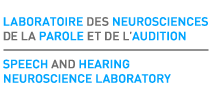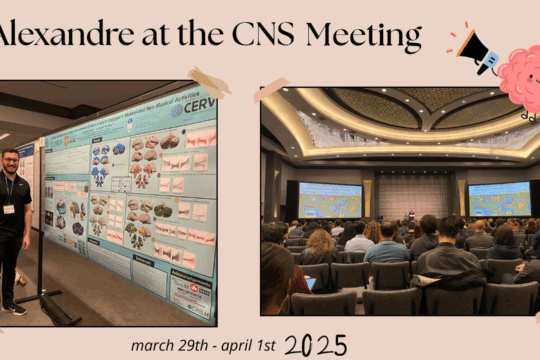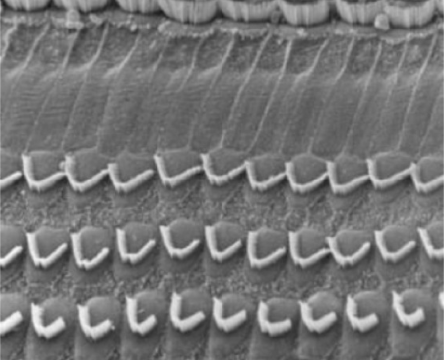
Priming is a well-known phenomenon in psycholinguistics, speech-language pathology, and cognitive psychology, frequently observed in people of all ages. When we are exposed to—or think about—a word or concept, our brain automatically activates items that share common features. Take, for example, a conversation between Pascale and Valérie in the laboratory (Figure 1):
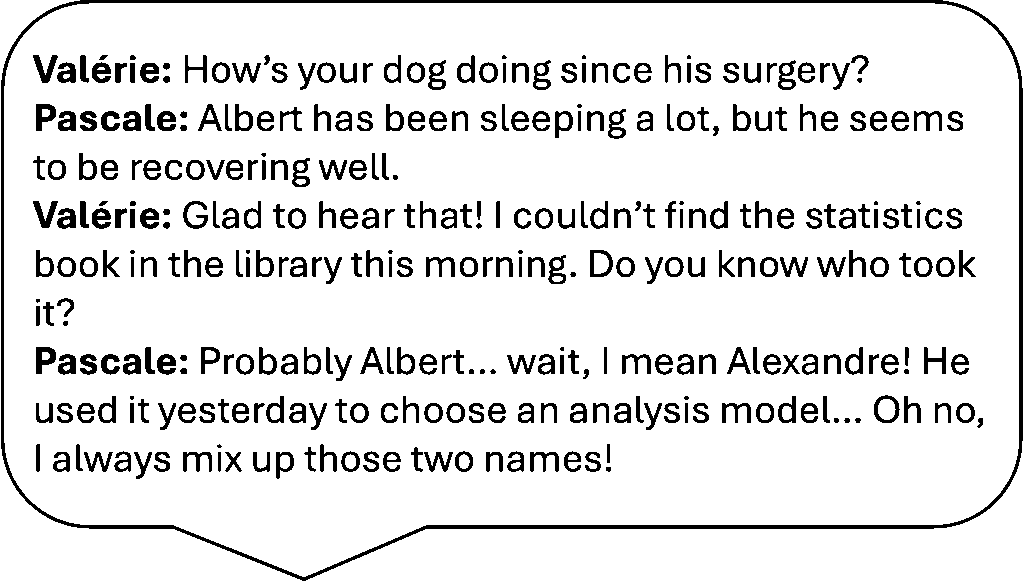
Do you recognize yourself in this kind of funny situation? In this context, a phonological priming effect occurred: since the first sounds of the words Albert and Alexandre are the same, Pascale’s brain can sometimes activate the wrong word!
Let’s take another example. Read the sentence below carefully:
The firefighters barely managed to put out the _______.
Did you involuntarily think of the word “fire” after reading this sentence? That’s another example of priming! Indeed, the word fire is strongly associated with the words firefighter and put out. This is a semantic priming effect, based on a meaning association rather than a sound association.
These phenomena reveal how our knowledge of words and concepts is organized in the brain. This information is arranged in vast, complex networks of interconnected items. When one item is activated in our brain, other items sharing common features are also activated, forming chains of activation of varying intensity (Figure 2).
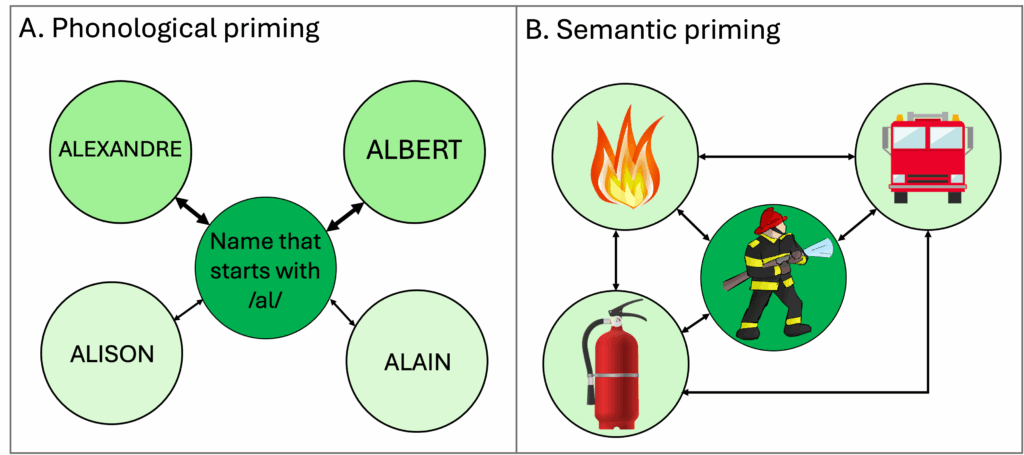
From the 20th century onwards, numerous scientific studies have demonstrated the existence of the priming effect, notably through word recognition tasks with priming. These tasks involve reading or listening to sequences of words or pseudowords [1], and indicating as quickly as possible whether a word is real or not (usually by pressing a button) (Figure 3). Some of the presented words are associated: in this context, the first word presented is called the prime, while the next word is called the target. Many of these studies show that words preceded by a prime are recognized more accurately and more quickly than words without a prime.

These results shed light on how our mental lexicon—that is, the set of words we know and store in memory—is organized. Every time we speak, read, or hear words, we access our mental lexicon to recognize and understand them. Findings from priming studies suggest that the mental lexicon is not just a simple dictionary arranged in alphabetical order. Rather, it acts like an internal search engine: as soon as we think of or are exposed to a word—or part of a word—our brain automatically activates suggestions, much like Google suggests different options when we start typing a search query.
These conclusions can be applied to different types of mental representations; indeed, many forms of priming have been discovered:
- Phonological priming: based on shared speech sounds
- Semantic priming: based on shared meaning
- Orthographic priming: based on shared letters
- Morphological priming: based on shared roots and affixes, as in act → action or teaches → teaching.
- Visual priming: based on shared visual features (e.g., in an object recognition task, an image of a chair can facilitate the recognition of another image of a table)
- …and many others!
Moreover, numerous variables influence the magnitude of this effect. Some of them include:
- Similarity: the more similar the prime is to the target, the faster the target will be activated.
- Time interval between prime and target: after a certain delay, the priming effect fades.
- Frequency and exposure: frequent words are generally primed faster than rare words. For example, if you are asked to think of a word that begins with the syllable “ca,” you are more likely to come up with cat much faster than catalysis, unless you are a chemist! Our daily exposure to different words thus impacts how our brain stores and uses them.
As mentioned earlier, priming can sometimes trick us in our choice of words. For instance, when Pascale wants to name Alexandre, a student in the lab, she may automatically activate the word Albert (her furry companion)—another name that shares common sounds and that she uses frequently in daily life. In such cases, her brain must sometimes “inhibit” (in other words, deactivate) the primed name that she does not intend to produce. This ability is called inhibition, which involves suppressing or blocking an automatic action, thought, or response. This process requires cognitive effort, which increases with age.
In the lab, we study inhibition in both young and older adults, as well as in musicians and non-musicians (see PICCOLO Project in Pictures and New Scientific Article on the Links Between Musical Activity Practice and Executive Functions for more details). The Stroop task is a classic example of an inhibition task. You can try it yourself in Figure 4.
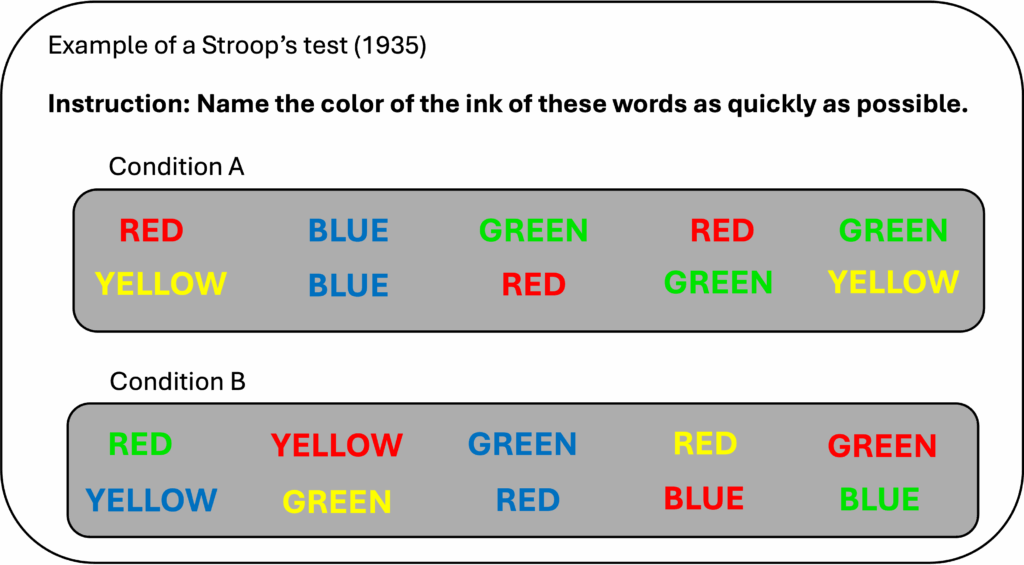
Did you notice that Condition B required increased attention? Did you sometimes hesitate or make mistakes? Was your reading slower? In this task, the ink color primes the name of the color (e.g., red ink primes the word red). In Condition A, the ink and the color name are congruent, so the prime speeds up the processing of the color name, allowing us to read very quickly. In Condition B, the ink color is incongruent with its name, creating a form of competition between activated items in our brain. Extra effort is therefore required to “block” the written word and to select the correct target.
What is the purpose of priming? Beyond occasionally tricking us, this type of brain organization allows us to process information more quickly, which provides many advantages.
For example, priming supports the comprehension of everyday conversations. Speech is a very fast, complex, and continuous stream of sounds that would be difficult to process quickly and efficiently without the benefit of this almost automatic “pre-activation” of associated words. In the example “the firefighters barely managed to put out the…”, you might have been distracted while hearing the word fire but still continue the conversation without difficulty, since your brain would already have activated/predicted the final word, and with very little effort.
Priming is also useful when someone is searching for a word in their mind. This phenomenon is called anomia, or more commonly, the “tip-of-the-tongue” state (for more on this, see our article: Tip of the tongue). When this happens, it is possible to provide cues (which are actually primes!) to help regain access to the full word in one’s mind. It is also possible to cue oneself by activating known features of the word or concept. Here is an example:

This word-retrieval technique can be used by parents or teachers to help a child remember a newly learned word. It is also taught to individuals who experience significant word-finding difficulties, either related to a developmental condition (since childhood) or to an acquired disorder, such as post-stroke aphasia or primary progressive aphasia.
In conclusion, the priming effect provides a window into the organization of our brain—a network of dynamic systems that allows us to spontaneously activate related words and ideas. While this mechanism can sometimes create confusion or amusing situations, it has many essential applications: it supports comprehension and learning, facilitates word retrieval, and can even be harnessed in education and speech-language pathology.
References:
Collins, A. M., & Loftus, E. F. (1975). A spreading-activation theory of semantic processing. Psychological Review, 82, 407–428.
Heyman T, Hutchison KA, Storms G. Uncovering underlying processes of semantic priming by correlating item-level effects. Psychon Bull Rev. 2016 Apr;23(2):540-7. doi: 10.3758/s13423-015-0932-2. PMID: 26335412.
Meyer, D. E., & Schvaneveldt, R. W. (1971). Facilitation in recognizing pairs of words: Evidence of a dependence between retrieval operations. Journal of Experimental Psychology, 90(2), 227–234. https://doi.org/10.1037/h0031564
Neely, J. H. (1977). Semantic priming and retrieval from lexical memory: Roles of inhibitionless spreading activation and limited-capacity attention. Journal of Experimental Psychology: General, 106(3), 226–254.
Ouyang, M., Cai, X., & Zhang, Q. (2020). Aging effects on phonological and semantic priming in the tip-of-the-tongue: Evidence from a two-step approach. Frontiers in Psychology, 11, Article 338. https://doi.org/10.3389/fpsyg.2020.00338
Stroop, J. R. (1935). Studies of interference in serial verbal reactions. Journal of Experimental Psychology, 18(6), 643-662. https://doi.org/10.1037/h0054651
Tulving, E., & Schacter, D. L. (1990). Priming and human memory systems. Science, 247(4940), 301–306.
Suggested readings:
- New Scientific Article on Brain Mechanisms Affecting Speech Production in Aging
- The Pathophysiological Mechanisms of Presbycusis
- How does the human brain work?
- Neurons
- Cognitive functions
- Chocolate and cognitive functions
- Aging and brain volume
- Conference on the neurobiology of language
- The profession of speech-language pathologist
[1] Pseudowords are sequences of letters or sounds that follow a plausible structure of a language but do not correspond to any real word in the lexicon. For example, smarken is a pseudoword because it does not exist in the English lexicon and has no known meaning. However, vrfnso would not be considered a pseudoword, since it does not follow a plausible sequence of letters or sounds in English. For more information on the use of pseudowords in scientific studies, see our post on the topic: Why do we use non-words?
